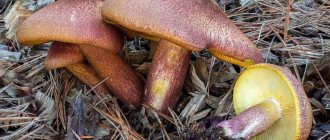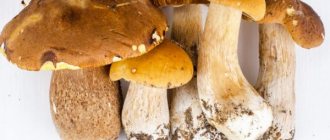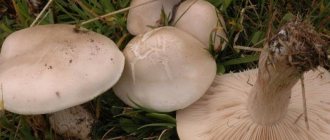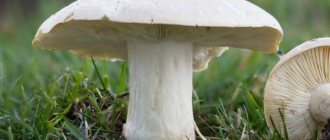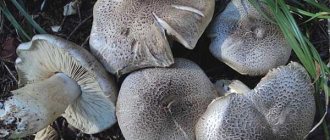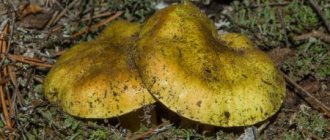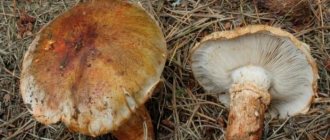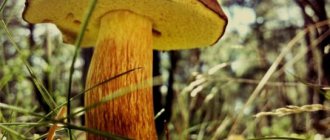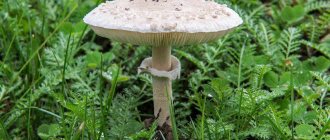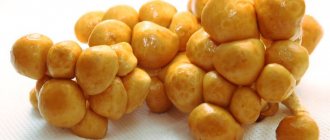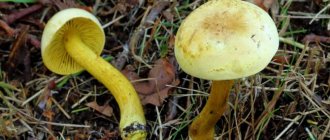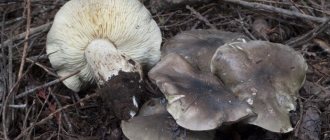Ryadovka yellow-brown is a representative of the large family of Ryadovkov. The Latin name is Tricholoma fulvum, but besides this, it has many other names. Some are given by mushroom pickers, others by the scientific community. Popularly, the mushroom is called pathology, nut mushroom. Scientists have assigned several botanical synonyms - yellow-brown, brown, red-brown, brown-yellow (Tricholoma flavobrunneum).
Description of the mushroom
Banded rower, or red honeyed rower, is part of the Rowadovka family (Tricholomotaceae) of the genus Ryadovka (Tricholoma).
Popularly known as the turtle. Latin name Tricholoma focale, scientific synonyms: Tricholoma zelleri, Armillaria zelleri.
The cap is up to 12–15 cm in diameter, medium fleshy. Young mushrooms have a convex shape, sticky, yellowish color. Over time, it becomes prostrate, dry, with a wavy edge down. The color varies from scarlet-brown to reddish-brown with dark radial stripes. In the center of the cap, scales are sometimes visible on the tubercle.
The hymenophore (the so-called lower part of the cap with the spore-bearing layer) consists of plates attached to the stem with a tooth. They are often or sparsely located and change color from white and cream to grayish or pale yellow. With age, they become covered with dark brown spots, especially closer to the edges. In young specimens, the plates are hidden under a fibrous shell (veil), which disintegrates during growth. The pulp when cut is dense, thick, white, under the skin it is reddish. No taste or slightly bitter, with a barely noticeable smell of fresh flour. The spores are wide elliptical in shape, white powder.
The leg is 4–11 cm long, in some specimens – 14 cm, up to 4 cm in diameter. Straight, fusiform or tapering towards the base, it can be curved. In the upper part of the stalk there is a fibrous reddish ring, above which the surface is smooth or with a small whitish flocculent coating. Under the ring - the color of the cap, in soft felt red-brown scales. Young mushrooms have dense stems, old mushrooms have longitudinal fibers and are hollow.
https://youtube.com/watch?v=5oOFKu_S914%3F
A little history
The mushroom was first described in 1838 by the Swede Elias Magnus Fries. In 1879, the German mycologist Adalbert Ricken gave the species the name accepted by modern taxonomy - Tricholoma focale.
Application
Row mushrooms are widely used in cooking and medicine. But before using fruiting bodies for medicinal purposes, be sure to consult your doctor.
In cooking
Edible varieties of row mushrooms become bitter if not properly processed. It involves soaking in cold water for several days. The water is drained regularly (2-3 times a day) and new water is added. Then the fruiting bodies are boiled for 20 minutes in salted water. As a result, the bitterness goes away.
Popular processing methods:
- salting for snacks;
- pickling;
- canning for the winter;
- some types are fried after boiling.
Drying row mushrooms is not advisable: the pulp without processing will be bitter and hard, and therefore not suitable for food. Fresh fruiting bodies are stored in the refrigerator for up to 3 days, salted ones for up to 3 months. Rows of deep-frozen and canned with sterilization are stored the longest without loss of quality and harm to health - up to 1 year.
In medicine
The beneficial properties of the rower are not limited to its attractive taste and the presence of a significant amount of microelements and vitamins in the pulp. The usefulness of the genus for medicine lies in the possibility of using them to obtain antibiotics in the near future. Thus, substances from which antibiotics and antitumor substances will soon be obtained have been found in the pulp of matsutake.
Cooking recipes
Only young specimens are used for cooking. Old mushrooms are tough and bitter, which certainly has a bad effect on the taste of the dish.
IMPORTANT. Mushrooms are not recommended for consumption by people with digestive problems, as they are a product difficult to digest and assimilate.
Primary processing
Mushrooms are a perishable product, which means they need to be processed no later than 4–5 hours after collection. First, they need to be sorted out and damaged and old fruiting bodies removed. Dry, cut and begin actual cooking.
Cooking
It is necessary to boil the mushrooms. In this case, you should drain the first broth after boiling.
Afterwards, you need to rinse the mushrooms with cold water and cook again for 30–40 minutes.
Pickling
Pickled rows can be stored in the basement or refrigerator for up to six months. To prepare it, take 1 kg of boiled mushrooms, put them in jars and pour in the marinade:
- 3 tbsp. l. 9% vinegar;
- 1 tbsp. l. salt;
- 1.5 tbsp. l. Sahara;
- 250 ml water;
- spices to taste (allspice, garlic, bay leaf).
Freezing
Only boiled mushrooms can be stored. At the same time, they do not lose their taste and beneficial properties at all for about 1 year.
Frying
The process takes a minimum of time, and the dish turns out tasty and aromatic. For 1 kg of rowing you will need 250-300 g of onions and 300 g of fat sour cream. Pre-boil the mushrooms, draining the water once.
Pour vegetable oil into a frying pan, fry onions in it, then add mushrooms and after 5 minutes sour cream. Spices can be anything you like. Best consumed hot.
IMPORTANT. Pre-treatment requires a lot of time and patience. Only in this case will the mushroom dish be tasty and safe. Cooking is the most important step that cannot be neglected.
Pickling
It is believed that the yellow-brown row is suitable for salting. This is the best way to prepare it.
To prepare a delicious snack you will need:
- 6 kg of mushrooms;
- 8 tbsp. l. coarse salt;
- Bay leaf;
- 20 cloves of garlic;
- black allspice peas;
- several dill umbrellas.
Preparation
- The lower part of the stem is removed from the mushroom and filled with cold water for three days. In this case, the water should be drained every 5 hours.
- Place a small layer of spices on the bottom of the jar, then a 5–6 cm layer of mushrooms. After that, more spices.
- The last layer should be salt. Cover the jar with clean gauze and a tight lid. After 30 days, the delicious snack is ready.
REFERENCE. This marinating recipe is also suitable for other types of edible mushrooms.
Contraindications
- people with stomach and gastrointestinal diseases;
- To old people;
- children under 7 years old;
- people with allergies or individual intolerances;
- Mycelium is planted in autumn at temperatures below +15℃.
- For better aeration, mushrooms need to be kept in order.
- To create the necessary conditions, the beds are protected from the sun and rain.
- When new mycelium forms, soil is added.
- After each harvest, it is necessary to add fresh soil.
False doubles of brown row
Some related species of rower are so similar to sweetweed that only microscopic analysis allows you to see the differences. The table shows characteristics of similar species.
| Double name | hat | Records | Pulp | Leg | Where is it found? | Food category |
| White-brown row (Tricholoma albobrunneum) | 3-10 cm in diameter, young mushrooms are wine-brown with dark veins, old mushrooms are red-brown. The skin cracks into small scales and is shiny. In wet weather - mucous. | Frequent, attached to the stem, white, pinkish-brown, in mature mushrooms - with reddish-brown spots. | White, dense, under the skin - with reddish veins. There is no or floury smell. The taste is mealy, bitter | Length 3-10 cm, thickness up to 2 cm, cylindrical or slightly thinned downwards. | In coniferous and mixed forests on poor soils. Forms mycorrhiza with pine. | Conditionally edible mushroom |
| Yellow-brown row (Tricholoma fulvum) | 3-15 cm in diameter, yellow-brown, smooth, without scales. Brilliant in rainy weather | Notched-grown, wide, frequent or sparse. Cream or light yellow, brown with dark spots as they age | Dense, with a bitter odor | 12-15 cm long, 0.5-2 cm thick, cylindrical or widened towards the base, fibrous, hard. The upper part is white, the lower part is the color of the cap | In deciduous and mixed forests. Forms mycorrhiza with birch | |
| Tied row (Tricholoma focale) | Diameter 5-10 cm, bright, with copper shades. The surface is fibrous-scaly, the edges are drooping | Frequent, attached to the stem with a tooth, white or yellowish | White, dense, elastic, reddish under the skin. There is no smell or a faint flour smell. Tasteless or bitter | 4-10 cm long, up to 3 cm thick, straight or fusiform, sometimes thinning downward. In young mushrooms it is dense, hard, in old ones it is hollow, longitudinally fibrous. | In pine forests on sandy soils | |
| Cowweed (Tricholoma vaccinum) | 3-8 cm in diameter, red-brown, with disheveled fringe along the edges, coarsely scaly | Rare, white or yellowish | White or yellowish, bitter | Length 5-9 cm, thickness 1-1.5 cm, straight, white at the top, cap-colored at the bottom | In spruce forests, sometimes in pine forests, rarely in mixed ones |
To better understand the difference between mushrooms, pay attention to the photo. There is no information about dangerous false doubles
There is no information about dangerous false doubles.
Yellow-red row - a little-known edible mushroom of category IV
The yellow-red honey fungus (Tricholomopsis rutilans), or yellow-red honey fungus (Tricholomopsis rutilans), captivates with its appearance and real mushroom smell. This beautiful mushroom with a yellow-red cap appears in forests at the end of summer and closer to autumn. Most often it is found near stumps or on the roots of coniferous trees. Many mushroom pickers have a question: is the yellow-red row edible? Is it worth collecting? And how to cook? On the one hand, for most it is an unknown mushroom, which, according to the main commandment of a mushroom picker, cannot be taken. It is safer to collect only well-known mushrooms. On the other hand, the yellow-red honey fungus looks quite edible. Let's try to figure out all these questions.
Description of the yellow-red row (yellow-red honey fungus)
Hat. The cap of the yellow-red row, or yellow-red honey fungus, has a yellow skin that is covered with red, dark red or red-lilac fibrous scales. Such that it gives the impression that the cap is slightly velvety, strewn with many tiny red strokes, dots and fibers. It is these scales that make the yellow skin appear red, red-pink or orange-red. As the mushroom grows, the scales remain mainly near the central part of the cap. The edges are noticeably discolored, retaining the yellow or yellowish-vanilla color of the skin.
The hat of young rowers has a convex shape. As the mushroom grows, it opens up, becoming almost flat. The skin is dry, slightly velvety. The cap plates are adherent and yellow.
The size of the cap depends on the age of the mushroom. Their diameter rarely exceeds 15 cm, more often it is up to 10 cm.
Leg. The dense leg of the yellow-red row, or the yellow-red honey fungus, is also yellow. Its height is up to 10 cm, diameter up to 1.5 cm. Numerous purple scales located longitudinally are noticeable on the leg.
Pulp. The pulp of this mushroom can be not only yellow, but also yellow-cream. It has a pleasant mushroom or vague smell. It is sometimes compared to the smell of decaying wood. The taste of raw pulp is bitter.
Where and when does the yellow-red row (yellow-red honey fungus) grow?
The mushroom loves coniferous trees. It settles in their roots, can climb onto stumps (especially old ones) or can be seen nearby in the grass. Prefers pine trees. The yellow-red row grows not only here, but also in other countries. Its description can be found in reference books and guides to mushrooms by foreign authors.
The growth time of the mushroom is summer and autumn.
Is the yellow-red row (yellow-red honey fungus) edible?
The yellow-red honey fungus, or yellow-red honey fungus, is edible. This is a category IV mushroom that can hardly be called tasty. But together with other mushrooms it can be cooked and eaten. The “inedible” label in certain reference books only indicates that the mushroom is unsuitable for mass consumption, and not that it is poisonous. In the USSR, the mushroom was not harvested according to GOST.
The yellow-red row must first be boiled and the first water must be drained immediately. Only after this the mushroom is cooked. Preferably at least 40 minutes. The row can be boiled, fried and salted. One of the best ways to prepare this mushroom is to marinate it with other mushrooms. The slight bitterness disappears. You can prepare (salt and pickle) according to the recipes that we gave in the article “Winter honey fungus (winter mushroom) appears in late autumn.”
Mushroom-twin of the yellow-red row (yellow-red honey fungus)
The yellow-red row, or yellow-red honey fungus, has such a characteristic appearance that it is difficult to confuse it with other mushrooms. However, it is worth recalling some external similarities with the poisonous and very bitter brick-red false honey fungus
This is important to know so as not to accidentally put the poisonous honey fungus in the basket instead of the edible row.
A clear difference will be the presence of a brick-red false thin cobwebby blanket covering the plates, or the remains of a fringe (not like a ring, but like rare flakes) in the upper part of the leg. The color of the plates also matters. It is whitish (in young honey mushrooms) or grayish, grayish-cream, greenish-yellow, olive (in adults). It can be brownish-green or black-green (in older ones).
The shape of the cap of young false mushrooms is bell-shaped, later rounded.
The leg is elongated, curved, fused from below with neighboring honey mushrooms. Its color is sulfur yellow or with a brown tint.
False brick-red honey fungus appears in August and mainly bears fruit in the fall (in large numbers in September). This bright mushroom cannot be collected. It is sometimes confused with autumn honey fungus, which leads to severe poisoning.
Description
Due to its inherent bitter taste, scaly mushroom (Tricholoma imbricatum), also known as sweet mushroom, brown mushroom, brownish row, fibrous-scaly mushroom, belongs to the category of conditionally edible mushrooms.
Differs in the following species characteristics:
- the initial rounded bell-shaped cap with rolled edges later becomes convex and flat-convex, with small scales in the central part, which retains a wide tubercle, the surface is matte and dry. The color is dark brown, in mature mushrooms it becomes somewhat lighter around the edges. The diameter of the cap can reach 10 cm (minimum - 3 cm).
- wide, frequently located plates often grow to the stem with a tooth or are self-shaped. At first they are very light, later they become creamy, then they darken to brownish, and in some places reddish-brown spots appear on them;
- white spores;
- fibrous cylindrical stalk, often curved; With age, cavities form in it. The light color of the upper part, as it moves to the base, gives way to brown with a yellowish or pinkish tint. Maximum dimensions - 2 cm in thickness, 10 cm in length;
- the light, white or creamy, dense pulp has a faint fruity odor and a mealy taste, more or less bitter.
Primary processing and preparation
The yellow-brown row is considered a conditionally edible representative of the mushroom kingdom and belongs to category IV. Those who have tried it say that it is not tasty and is very bitter. This is probably why it is not popular among mushroom pickers. But if you know the secrets of its preparation, the row will turn out to be quite a tasty addition to your table.
The yellow-brown row is harvested only at a young age, while the fruiting bodies are not very saturated with bitterness. It is usually salted or pickled together with other types of mushrooms. It can also be boiled or fried, but after preliminary boiling for 40 minutes and draining the water in which the rows were located.
The yellow-brown row is a completely unremarkable mushroom in appearance, but it will grow even when the year is dry and there are no mushrooms in the forest. This is probably why it is still sometimes collected. But in a mushroom year, most often this row is simply bypassed, giving preference to other representatives of the mushroom kingdom.
https://grib-info.ru/syedobnie/ryadovki/ryadovka-vodnopyatnistaya-zhyolto-buraya-i-zolotistaya.htmlhttps://fermilon.ru/sad-i-ogorod/griby/ryadovka-zhelto-buraya-foto- i-opisanie-kak-gotovit.htmlhttps://gribowiki.ru/condit/ryadovka-zhyolto-buraya.htmlhttps://mirgribnika.ru/uslovno-sedobnye/ryadovka-zhelto-buraya.html
Synonyms and popular name
In the scientific literature, this type of mushroom is designated as yellow-brown row (Tricholoma fulvum). There is an opinion that the name comes from the property of mycosis-forming organisms with a specific cap color to be located in a row or in large groups. In addition, in the process of studying, the Swedish botanist Elias Magnus and the American mycologist Charles Horton Peck introduced many botanical synonyms. If you show interest and want to learn more from specialized sources about the differences between these mushrooms, pay attention to the following names:
- Agaricus flavobrunneus;
- Agaricus fulvus;
- Agaricus nictitans;
- Callistosporium marginatum;
- Clitocybe marginata;
- Gyrophila fulva;
- Monadelphus marginatus;
- Tricholoma flavobrunneum;
- Tricholoma nictitans.
In everyday life, yellow-brown rows are often called orange, brown and red-brown. All these names are associated with shades of the mushroom cap. In addition, the name “plantain” is rarely found, due to the wide distribution of the species.
Appearance and habitat
The mushroom row or talker forms fruiting bodies with a clearly defined division into a cap and a stalk. Representatives of the genus have a flat cap (this is typical for mature mushrooms, but in young ones it is hemispherical), with a lamellar hymenform, and differs in color in different species. The leg is long, cylindrical in shape.
Rowers are ground-based species of mushrooms. More often, the mycelium chooses soil near coniferous trees. Individuals grow in small groups. They can form ring colonies - “witch circles”. There are many places where row trees grow: they are forest, meadow, grow in groves and even parks.
Geographically, the types of rows cover the whole of Russia. The species also grows in Crimea. Crimean mushrooms are actively collected from early spring to mid-winter due to the warm climate. The main time for fruiting of the genus is autumn, because it is the autumn fruiting bodies that reach their peak of fleshiness and quantity. Some species appear in the spring, while others bear fruit until the cold weather. The row mushroom combines many species, the description of which will be useful to every mushroom picker so as not to send false mushrooms to the basket and then to the plate.
Where does it grow
The brown-yellow row is unpretentious when choosing a place of growth. It grows on any soil and is drought-resistant. Fruits from mid-summer to October. The mushroom grows in northern America, Western and Eastern Europe, Russia, the Far Eastern Federal District and the Urals. Usually creates groups.
Beneficial features
Representatives of different species belonging to the genus Ryadovka contain vitamins A, group B, PP, E. The pulp contains thiamine and riboflavin, as well as useful trace elements calcium, magnesium, potassium, sodium, copper, phosphorus, zinc. Chitin and fiber contained in the cell walls cleanse the intestines of toxins.
Forest gifts are not a low-calorie product; they quickly fill you up. Per 100 g from 30 to 40 kcal. The pulp contains almost no fats and carbohydrates; most of the mass is occupied by water and protein. Forest species contain all types of amino acids (including essential ones) that humans need for normal life.
Row mushrooms when consumed regularly:
- strengthen the immune system;
- lower cholesterol levels in blood vessels;
- improve vision;
- work as antioxidants;
- lower blood sugar levels.
Yellow-red row: photos and properties
Synonyms: red row, yellow-red false honey fungus, yellow-red honey fungus, pine honey fungus.
Description. The cap is 3-15 cm in diameter, convex, then prostrate, reddish-yellow or yellow-orange with a lilac tint, dry, matte, velvety, with small dots or scales of purple or reddish-brown color.
As you can see in the photo of the yellow-red row, the flesh of the mushroom is bright yellow, thick, soft, with a sweetish taste and sour smell; in old mushrooms it is a little bitter. The plates are golden-yellow, sinuous, frequent, and wide. Leg 3-10 X 0.5-2.5 cm, cylindrical or thickened at the base, yellowish, with red flake-like scales, often hollow with age.
The yellow-red rower inhabits coniferous and mixed forests with the participation of pine and spruce, on and near stumps and roots, near dry trunks, usually in small groups. The fruiting period is July-October.
Medicinal properties: The main bioactive component isolated from this mushroom is fomecin B, which has a powerful anti-cancer effect. It showed complete suppression of HeLa, MDCK and FL cancer cell lines. Polysaccharides isolated from the mycelial culture of yellow-red honey fungus inhibit the growth of sarcoma-180 and Ehrlich carcinoma in laboratory mice by 60%.
Use in cooking: Edible mushroom of average quality, not very popular among the population. Young mushrooms are collected and, after preliminary boiling, consumed fresh, salted and pickled.
Among the wide variety of mushrooms of this family, there are poisonous, conditionally poisonous, edible, but with a high level of toxicity, and safe for consumption specimens.
Gourmets note the exceptional taste of certain types of rowing, but everyone is advised to try it. In addition to their pleasant taste, these mushrooms have a number of useful and healing properties:
- are a natural source of vitamins B, D2 and D7, synthesize vitamins K and PP;
- saturate the human body with potassium, calcium, iron and phosphorus;
- supply amino acids;
- act as natural antibiotics that increase the body's resistance to bacteria, viruses, and cancer cells.
They have a beneficial effect in the treatment of the following pathologies:
- diabetes
- disturbance of gastrointestinal motility
- rheumatism
- nervous system disorders
- oncology.
What mushrooms can be confused with
Nowadays, botanists know about a hundred species of mushrooms from the genus Ryadovka. Therefore, it is easy to make mistakes when collecting such trophies. Even experienced mushroom pickers often confuse the yellow-brown variety with:
- Poplar row (poplar) - distinguished by its white hymenophore. Grows under aspens and poplars. It is considered conditionally edible.
- Ryadovka white-brown (lashanka) is a conditionally edible mushroom, distinguished by a brown cap with dark veins. These mushrooms have snow-white flesh without any signs of yellowness.
- Yellow-red row (pine honey agaric) - characterized by a velvety dry cap with small red-brown fibrous scales. It is considered conditionally edible.
- Ryadovka melanchoides (bandaged) - obvious signs of this conditionally edible mushroom are the heterogeneous color of the cap. It may have yellow-brown, reddish and even greenish tints. Prefers poor soils under pine trees.
- Soap mushroom is an inedible mushroom, characterized by a fruity-soapy smell and olive impurities in the color of the cap. When cut, the yellowish flesh begins to turn red.
- Serena sulfur (sulfur-yellow) is a poisonous but low-toxic mushroom. Most often they are confused with old specimens, on the cap of which a rusty-brown tint appears. The young fruiting body is characterized by a gray-yellow color. Having cut such a trophy, you will immediately feel an unpleasant, pungent smell of tar, hydrogen sulfide or acetylene.
Read also: We meet the “American guest”
Useful properties of yellow-brown rows.
The composition of the rows is quite rich - they contain minerals (potassium, manganese, selenium, calcium, copper, iron, sodium, zinc), 18 types of amino acids, all groups of B vitamins, as well as vitamins A, C, D, K and PP. And due to the content of the substance “trehalose” in the rows, they have a sweetish taste.
Rowers are natural antibiotics; they destroy many types of pathogenic bacteria. In addition, they have antiviral, anti-inflammatory, antioxidant and immunomodulatory properties. With regular use of rows, heart function is normalized, heart rhythm is restored, the condition of blood vessels improves, the amount of sugar in the blood decreases, and blood pressure drops. These mushrooms help improve performance, relieve stress, and activate the brain. Mushrooms of this type have a positive effect on the functioning of the stomach and intestines. The structure of the liver improves, toxins and waste are removed from the body.
With the systematic use of yellow-brown rows, the possibility of the formation of cancerous tumors is reduced, in addition, these mushrooms suppress the growth of negative bacteria. They increase resistance to influenza and tubercle bacilli.
In folk medicine, infusions are made from the rows, which are used in the form of lotions for various skin diseases. In cosmetology, powder from dried fruiting bodies is used, on the basis of which a skin lotion is made; it helps eliminate acne, excess oiliness and irritation.
Contraindications for the use of yellow-brown rows.
Raw rows can cause quite serious poisoning. Fruit bodies tend to accumulate various anthropogenic substances, for example, cadmium, mercury, and pesticides. Old, overripe mushrooms are also harmful to the body.
Overeating may cause abdominal pain. It is not recommended to use these mushrooms for chronic diseases of the stomach and intestines, gallbladder and low acidity.
Similar species.
The poplar row is similar in appearance to the yellow-brown row, but it differs in its white hymenophore and the fact that it grows under poplars and aspens. Its cap is slightly convex at first, and then straightens out. The structure of the cap is fleshy. The color of the cap is brownish, there may be a reddish tint. The leg is cylindrical, solid, pink-brown in color. When pressure is applied, brown spots appear on the stem. The pulp is soft, with a pleasant smell, and brownish in color.
These conditionally edible mushrooms bear fruit from August to October. Poplar rows grow in whole ridges. They can be found in deciduous forests and parks.
The white-brown row also has an external resemblance to the yellow-brown row. This is a conditionally edible mushroom with a convex-spread or flat cap. The surface of the cap is covered with small scales; in damp weather, a layer of mucus is noticeable on it. The color of the cap is chestnut-brown or brown. The pulp is well developed, dense, white. It does not taste bitter and is odorless. The leg is cylindrical, solid inside. The upper part of the leg is smooth, white, and the bottom is longitudinally fibrous, brown or brown.
White-brown rows bear fruit from August to October, but sometimes they can be found in November. They grow mainly in coniferous forests, form mycorrhizae with pine trees, and can settle in deciduous forests. The range of white-brown rows is very wide.
Possible harm
The main danger of any mushroom is the accumulation of toxins, metals and wastes contained in the atmosphere. That is why it is not recommended to go out on a quiet hunt near dangerous industries and roads.
Overeating can also negatively affect the body's condition. If a person overdoes it and consumes too much rowing, it is likely that he will experience pain in the stomach and intestines, nausea, and even inflammation of the walls of the stomach or gall bladder.
Brown rower is an accessible but secretive mushroom. But still, anyone who finds it and cooks it according to the correct recipe will absolutely get an excellent dish and a lot of pleasure from the taste and light aroma of the mushroom.
Description of white-brown row (tricholoma albobrunneum) or white-brown
Latin name: Tricholoma albobrunneum. Family: Row.
Synonyms: brown row, white-brown row, sweet.
Hat: diameter from 4 to 10 cm, with a rolled edge. In the proposed photo of a white-brown row, you can see the shape of the cap: at a young age it is hemispherical, then it becomes convex-spread with a tubercle in the middle. The surface is fibrous and cracks over time, forming the appearance of scales. The color varies from brown with a reddish tint to chestnut brown.
Leg: height from 3 to 8 cm, less often up to 10 cm, diameter from 0.6 to 2 cm. The surface is smooth, longitudinally fibrous below, the outer fibers create the appearance of scales. The color where the plates attach to the stem is white, then turns brown. The stem of the white-brown row mushroom has a cylindrical shape when young, but when mature it tapers towards the base and becomes hollow.
Pulp: white with a brown tint, dense, odorless, has a slight bitterness. Some sources say that the mushroom has a mealy odor.
Laminae: adherent to teeth, frequent, white, with noticeable small reddish spots.
In this case, preliminary heat treatment is used for 30-40 minutes to remove bitterness.
Similarities and differences: the white-brown row is similar to the fibrous-scaly row, but the latter is distinguished by a thoroughly scaly cap, dullness and lack of stickiness in rainy weather.
The mushroom also has similarities with the yellow-brown row. However, the leg of the yellow-brown “sister” has a ring of thin filmy tissue on it, as well as a slimy feeling under the cap and a bitter taste.
Spotted rower is another species that is similar to the white-brown rower. This is a mildly poisonous mushroom, characterized by the presence of dark spots on the surface of the cap, which are located along the edges in circles or radially. This mushroom does not have a tubercle in the center, the asymmetrical convexity of the caps in older specimens is very pronounced, and the flesh has a bitter taste.
Distribution: white-brown row or white-brown row begins to bear fruit in August and continues almost until the end of October. Prefers pine or coniferous forests, less common in mixed ones. It grows in small groups, forming rows, and is less common in single specimens. It is found throughout Russia and Europe in coniferous forests and pine forests.
Crowded row (Lyophyllum decastes)
HABITAT: forests, parks and gardens, lawns, near stumps and on soil rich in humus, grow in large groups.
SEASON: July - October.
The cap is 4-10 cm in diameter, sometimes up to 14 cm, at first hemispherical, later convex. The first distinguishing feature of the species is the fact that the mushrooms grow in a dense group with fused bases in such a way that they are difficult to separate. The second distinctive feature of the species is the lumpy, uneven surface of the cap, brownish or gray-brown in color with drooping wavy edges. In the center the color of the cap is more saturated or darker than at the periphery. There is often a small wide tubercle in the center.
The leg is 4-10 cm high, 6-20 mm thick, dense, completely white at the top, gray-white or grayish-brown below, sometimes flattened and curved.
The pulp is white, thickened in the center of the cap, the taste and smell are pleasant.
The plates are adherent, dense, white or off-white, narrow.
Variability: The mushroom varies greatly in color depending on the stage of development, time and humidity of the season.
Poisonous similar species . The crowded rower can be confused with the poisonous yellowish-gray entoloma (Entoloma lividum), which also has wavy edges and a similar gray-brown cap color. The main difference is the smell of flour in the entoloma pulp and the growth is separate and not crowded.
Cooking methods: salting, frying and marinating
Edible , category 4.
Distribution and fruiting period
The habitats of the yellow-brown beauty are deciduous, most often birch forests, as well as mixed and rarely coniferous ones, in the northern temperate zone (North America, western and eastern Europe, the Urals, northern and middle parts of Russia, the Far East). The fungus forms mycorrhiza with birch trees, and sometimes with representatives of conifers.
The yellow-brown row usually grows in large groups, quite often forms “witch circles”, and is rarely found alone. The fruiting period begins at the end of August and lasts until October.
Quite often found on the path of lovers of “quiet hunting”, it always bears fruit actively and copes well with drought.
Collection rules
The first rule is to find a place where the yellow-brown row prefers to grow. It can be a birch forest, mixed, or less often coniferous. Then:
- “Silent hunting” can be started during the fruiting season of the species.
- Try to collect mushrooms in places away from roads.
- Take young specimens.
- You can cut the leg with a knife, you can twist it. For rowing, this does not matter much.
Place the collected mushrooms in a basket and process them the same day. It is not recommended to leave it raw for the next day. A visual overview of the process:
Places of growth
The generic name of the gray row is Tricholoma. This group includes many species, including poisonous and conditionally edible. They are also found, and the second group is not toxic to humans, but has no nutritional value. Thus, all varieties of tricholoma are divided into 4 groups. From the point of view of botanists, Ryadovka is a lamellar above-ground mushroom, the genus is Agaricaceae, the family is Ryadovka or Tricholomaceae.
The pulp of the fruiting body exudes a light fruity aroma and tastes slightly sweet. The color can be light gray, gray-lilac, pale purple, white. Purple-legged mushrooms often grow where there is a lot of ash, but they can also be found in other forests, as well as in grassy steppes. In years with favorable weather, fruiting begins in mid-spring and continues until the second ten days of October.
Earthy gray
The plates are wide, often located, almost white in young specimens, brownish or red-brown in older specimens. The pulp has a delicate aroma, characteristic of edible mushrooms, and has a nutty flavor. At the fracture, the mushroom is white; after a while, the damaged area becomes light red or yellow. Colossus rower forms a mycorrhizal symbiosis with pine and is common in Russia, Japan, North Africa and some European countries. Fruiting begins in early or mid-August and continues throughout September.
Honey fungus
Another type of rowing is called nut honey fungus. It is known as brown, red-brown and yellow-brown. This mushroom is suitable for consumption, but even after prolonged heat treatment the pulp is slightly bitter. In young specimens the cap is slightly convex, less often rounded, and becomes flat with age. There is a small bulge in the middle. In the first days, the skin is smooth and sticky, then it becomes rough and covered with scales. The cap grows up to 15 cm in diameter, is colored light brown at the edges, darker in the center, with a red tint.
This species grows only in birch forests. Peak fruiting occurs in August and September. The brown row has white, loose pulp with a mealy taste and aroma. The plates are yellowish, can be located either sparsely or frequently, and as the fungus ages, they acquire a brown color. The leg is yellow-brown below, white above interspersed with brown fibers.
These are the most common varieties of rowing suitable for consumption. According to their descriptions, they can be easily distinguished from poisonous and inedible.
Ryadovka (Tricholoma) belongs to the genus of lamellar ground fungi from the Ryadovka family. Their hats are usually colored and hemispherical in shape. Convex while the fruiting bodies are young, as the mushroom ages they acquire a flatter shape. The edge of the cap is wavy, usually bent or curled outward. From above, the mushroom looks fibrous or scaly.
The leg is dense, with plates adhered to it. Occasionally there is a membranous cover. A faint ring on the stem remains from a short-lived private bedspread. The fungal spores are colorless and have a smooth surface. Many types of rows smell of flour and often change their external specific characteristics, which makes them difficult to identify from photos. Rowing plants, edible and inedible, grow throughout almost the entire territory of Russia and beyond its borders.
Poisonous or edible?
To date, scientists have not yet decided whether this species is poisonous. Many consider it conditionally edible. In Europe, this species is not eaten because it is believed that it contains a toxin that can paralyze nerve cells and the human respiratory tract. Also, this substance, according to European scientists, causes poisoning and has a detrimental effect on all parts of the brain. In Russia, this mushroom is often eaten after processing. Usually the mushroom is fried or boiled. So, it is possible that in Russia they eat a completely different mushroom, because there are more than 60 species of Govorushka and they are all very similar to each other. It is possible that this is the same species, but the toxicity of the fungus depends on the stage of its development.
Inedible types of rows
Pseudowhite (Tricholoma pseudoalbum)
- Lives alone or in small groups in mixed or deciduous forests.
- Grows from August to October.
- The cap is hemispherical at the beginning of growth, later it becomes convex, reaches a diameter of 3-8 cm. Its color is white, cream or slightly pinkish.
- The leg grows up to 3-9 cm in height and 1.5 cm in width. It is the same shade as the cap: white, pinkish or creamy white.
- The pulp has a mealy odor, is white at first, then slightly yellowish.
- The plates are cream-colored, at first slightly grown in, and then almost free.
- It has an unpleasant taste, so it is not eaten.
This species is similar in shape and size to Mayweed (Tricholoma gambosa). But the latter has greenish or soft pink areas on the cap.
Stinky (Tricholoma inamoenum)
- Grows in groups or singly in humid areas of deciduous or mixed forests.
- The growing season is from June to October.
- The cap usually reaches 3-8 cm in diameter, but can grow up to 15 cm. Its surface is smooth, often lumpy, ivory or white, and as it grows, brownish or yellowish spots appear. At the beginning of growth, the cap has a hemispherical shape, and with age it becomes convexly spread, with slightly wavy edges.
- The length of the leg grows up to 5-15 cm, and the thickness up to 2 cm. It has a cylindrical shape, elastic and dense, the color is identical to the cap.
- The white flesh is fleshy and dense. Representatives of this species are distinguished by a strong stinking odor, which is characteristic of both young and old mushrooms. The smell is similar to lamp gas.
- The adherent plates of medium frequency can be white or cream in color.
- Due to the stench, these mushrooms are not edible. Even cooking does not eliminate it.
Often, at the beginning of growth, you can confuse the stinking row with edible sulfur (Tricholoma portentosum). But it lives up to its name and the stinky smell is hard to miss. And the gray row has a pleasant mushroom aroma.
Characteristics and description
Like other cap-footed mushrooms, the body of the row consists of a stem and a cap. Both parts can take different forms, and their shades often vary. The upper part of a young row can be in the form of a ball, cone, bell or flattened hemisphere. The size of the cap in diameter for young mushrooms is 3-4 cm, for adults - 15-20 m or more.
The older the mushroom, the flatter its cap becomes. At the edges it can be either flat or curved inward or outward. Sometimes there is a small bulge left in the center, but in some species there is none. The mushroom has a skin that comes off in thin strips when pulled. The surface of the cap can be:
The row forms a stalk 3−10 cm high. In a young mushroom it has a thickness of 0.7−0.8 cm, in an old one it reaches 2.3 cm. Sometimes the stalk grows the same throughout its entire height, but it also happens that it narrows or expands up. There are also mushrooms with club-shaped bases.
The color of the flesh of the leg is usually brownish, gray-pink or pink-brown, but only in the middle and lower parts. Under the cap itself there is a small area that is lighter than the rest of the mushroom. In some subspecies, a protective ring is located in the same place - what remains of the fibrous cover covering the plates. The surface of the leg can be velvety, covered with scales (which makes it appear fluffy), fibrous or completely smooth.
Description of the pigeon row and differences from the white variety
Latin name:
Tricholoma columbetta.
Family:
Ordinary.
Synonyms:
the row is bluish.
Hat:
hemispherical or bell-shaped, fleshy, can reach up to 12 cm in diameter. As they grow older, the cap opens and becomes flat, and its edges bend down. You can often see a small bump in the center. The surface is sticky, in young specimens it is radially fibrous with the presence of light scales. The color of the cap is white, sometimes with pinkish or bluish spots.
Leg:
height up to 10 cm, thickness up to 3 cm, round, smooth or tapering downwards. The surface is silky, smooth, fibrous, dense inside. The color of the stem of the bluish row is white, and a slight bluish-green tint is noticeable at the base.
Pulp:
elastic, dense, fleshy, white in color. The smell and taste are pleasant, but subtle. When exposed to air, the flesh of the mushroom acquires a pink tint, and when exposed to high temperature it turns red.
Records:
free, wide, frequent, white at a young age, and over time they acquire a reddish-brown color.
Edibility:
edible mushroom.
Application:
Suitable for preparing various dishes and preparations for the winter. Pigeon row is good in soups and sauces. It perfectly decorates a holiday table in the form of a pickled or salty snack. The fruit body is also dried for long-term storage. Many experienced mushroom pickers note that this mushroom adds a unique aroma to meat dishes. However, before cooking, it must be soaked in cold water and then boiled for at least 15 minutes. Both young and adult specimens are used for food. In addition, even those fruiting bodies that have survived the first frost are suitable for processing. Such taste qualities encourage novice lovers of “silent hunting” to definitely study the description and photo of the pigeon row mushroom, so as not to lose sight of it in the forest.
Similarities and differences:
This species is similar to white row (Tricholoma album) - a dangerous poisonous mushroom. However, the differences between the pigeon row and the white variety are quite easy to notice. The latter emits a sharp, disgusting odor, which helps determine the edibility of the mushroom.
Spreading:
The bluish rower is a rather rare species in its family. The mushroom grows mainly in mixed and deciduous forests. Most often it can be seen near birch and oak trees. Sometimes it can settle in pastures and meadows. It grows singly or in small groups from August to September.
Taxonomy:
- Division: Basidiomycota (Basidiomycetes)
- Subdivision: Agaricomycotina (Agaricomycetes)
- Class: Agaricomycetes (Agaricomycetes)
- Subclass: Agaricomycetidae (Agaricomycetes)
- Order: Agaricales (Agaric or Lamellar)
- Family: Tricholomataceae
- Genus: Tricholoma (Tricholoma or Ryadovka)
- Species: Tricholoma columbetta (Tricholoma columbetta)
